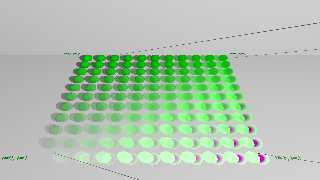|
 |
I noticed this recently, and wanted to make some reference renders.
As you can see in the bottom right, there is a pronounced magenta.
It gives me a headache to look at, and I can't really puzzle out what the
mechanism of this is.
White plain and wall, white light. Nothing special.
//#######################################################################
#version 3.7;
global_settings {assumed_gamma 1.0}
#include "colors.inc"
#include "textures.inc"
#include "shapes3.inc"
camera { location <16, 35, -47> look_at <16, 0, -15>}
//camera { location <30, 10, -36> look_at <30, 0, -32>}
light_source {<40, 50, -60> White}
//###########################################################################################
// floor
plane {<0, 1, 0>, 0 hollow // normal vector, distance to zero ----
texture {
pigment {color rgb <1, 1, 1> }
} // end of texture
} // end of plane
// upright
plane {<0, 0, -1>, 0 hollow // normal vector, distance to zero ----
texture {
pigment {color rgb <1, 1, 1> }
} // end of texture
rotate <0, 0, 0>
} // end of plane
#declare Dia = 2;
#for (X, 0, 10)
#for (Z, 0, 10)
sphere{<X*Dia*1.5, Dia, -(Dia*2)-(Z*Dia*1.5)>, Dia/2 pigment {rgbft <0, 1, 0,
X/10, Z/10>}}
#end // end for Z
#end // end for X
text {ttf "arial.ttf", "f=0, t=0", 0.02, 0.0 // thickness, offset
texture{ pigment {color rgb <0, 1, 0>*0.4 }
finish {specular 0.6 phong 1}
} // end of texture
rotate x*90
scale <1, 1, 1>
translate <-4.5, 4, -5>
no_shadow
} // end of text
text {ttf "arial.ttf", "f=1, t=0", 0.02, 0.0 // thickness, offset
texture{ pigment {color rgb <0, 1, 0>*0.4 }
finish {specular 0.6 phong 1}
} // end of texture
rotate x*90
scale <1, 1, 1>
translate <31, 4, -5>
no_shadow
} // end of text
text {ttf "arial.ttf", "f=0, t=1", 0.02, 0.0 // thickness, offset
texture{ pigment {color rgb <0, 1, 0>*0.4 }
finish {specular 0.6 phong 1}
} // end of texture
rotate x*90
scale <1, 1, 1>
translate <-4.5, 4, -35>
no_shadow
} // end of text
text {ttf "arial.ttf", "f=1, t=1", 0.02, 0.0 // thickness, offset
texture{ pigment {color rgb <0, 1, 0>*0.4 }
finish {specular 0.6 phong 1}
} // end of texture
rotate x*90
scale <1, 1, 1>
translate <31, 4, -35>
no_shadow
} // end of text
#declare R=0.02;
cylinder {< 0, 0, -2>, <40, 50, -60>, R texture {pigment {White} finish
{specular 0.6}} no_shadow}
cylinder {< 0, 0, -32>, <40, 50, -60>, R texture {pigment {White} finish
{specular 0.6}} no_shadow}
cylinder {<30, 0, -2>, <40, 50, -60>, R texture {pigment {White} finish
{specular 0.6}} no_shadow}
cylinder {<30, 0, -32>, <40, 50, -60>, R texture {pigment {White} finish
{specular 0.6}} no_shadow}
Post a reply to this message
Attachments:
Download 'filter_and_transmit.png' (314 KB)
Preview of image 'filter_and_transmit.png'

|
 |
|
 |
Am 08.08.2016 um 03:54 schrieb Bald Eagle:
> I noticed this recently, and wanted to make some reference renders.
> As you can see in the bottom right, there is a pronounced magenta.
>
> It gives me a headache to look at, and I can't really puzzle out what the
> mechanism of this is.
When POV-Ray encounters a surface with `transmit T`, it computes the
effective resulting colour (`Ce`) as a weighted average of the following
two components:
- The effective colour the background would have if the surface was
entirely transparent (`Cb`).
- The effective colour the surface would have if it was opaque (`Cs`).
The weighting factors for the two components are `T` and `1-T`,
respectively. Thus, the formula is:
Ce = Cb*T + Cs*(1-T)
When POV-Ray encounters a surface with `filter F`, it computes the
effective resulting colour as a weighted average of the following two
components:
- The effective colour the background would have if the surface was
entirely transparent, multiplied by the surface's pigment colour (`Cb*Cp').
- The effective colour the surface would have if it was opaque (`Cs`).
The weighting factors for the two components are `F` and `1-F`,
respectively. Thus, the formula is:
Ce = Cb*Cp*F + Cs*(1-F)
Now how should the two mechanisms interact if both are used? In that
case, POV-Ray uses:
Ce = Cb*(Cp*F+T) + Cs*(1-F-T)
As a result, if F+T>1, `Cs` will be multiplied with a negative value,
resulting in a negative colour contribution from the surface. Add this
to a positive colour contribution from the background, and you'll get
the complementary colour, which in case of green happens to be magenta.
=> For realistic results, make sure `filter` plus `transmit` never
exceeds 1.
Post a reply to this message
|
 |




![]()